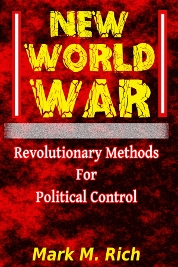Main Menu
Updates
-
Update: December 22, 2025
No Book Reviews....more - Important Updates
- Previous Updates
- Attack Log
Donations
- I accept cryptocurrency & PayPal
Available Books
New World War: Revolutionary Methods for Political Control
Dedication & Thanks
Volume I: Current Political Situation
- Overview
- Introduction
- Revolution in Warfare
- The Other World
- Dictatorship Creation
- The Groups Facilitating the Revolution
- Their Goal is Neo-Feudalism
- Problem-Reaction-Solution
- Volume I Commentary
Volume II: The New War
- The New War
- The New Enemy
- Initiatives to Remove Civil Liberties
- The Investigation
- Surveillance Technology and Methods
- Mind-Reading
- Volume II Commentary
Volume III: Weapons of The New War
- Introduction to Nonlethal Weapons
- Psychological Operations
- Introduction to Directed-Energy Weapons
- High-Powered Microwaves
- High-Powered Lasers
- Sonic Weapons
- Computer Network Operations
- Microwave Hearing
- Silent Subliminals
- Use of Citizen Informants
- Chemical and Biological
- Weather Warfare
- Miscellaneous Weapons and Tactics
- Volume III Commentary
Volume IV: The Coverup
- Volume IV Introduction
- Schizophrenia Spectrum Disorders
- Control of the Medical Industry
- Another Look at Schizophrenia
- Political Considerations
- Punitive Psychiatry in Communist Russia
- Coverup Initiatives
- Volume IV Commentary
- Conclusion
Appendix
- A Brief History of PsyOp
- Small-Scale Wars
- Nongovernmental Organizations
- Human-Computer Intelligence Network
- Electronic Tyranny
- Other Devices Connected to the GIG
- My Experience
- Sources
Other Sites
Researchers have mentioned that throughout history particular characters are continually the cause of wars, occupations, genocide, and other acts of human degradation. Unfortunately, because the thought-processes of these characters are so completely bizarre, humanity has not been consistently successful in recognizing and stopping them.
At this time, those who have studied such events are certain that the characters who are usually responsible are psychopaths. We now have information which we lacked centuries ago that allows us to comprehend what is happening as part of a larger historical pattern.
A new area of study has been created to help us understand and prevent this destructive cycle.1 An accurate profile of these people, how they are able to do it, and the attributes of a system that has fallen under their control, has been documented. An explanation of how they accomplish it will be provided now.
In any society during any time period psychopaths create small active networks to further their ambitions. Their primary consideration is how they will go about gaining control over the population. Members of these networks often seek positions of political influence. Their pursuit of power is hyperactive.
They believe it is necessary to transform society into what they consider to be a utopia, where they are not rejected by the normal people for what they are, or need to submit to their laws and customs. If they have access to tremendous wealth, it will be used for this purpose. In their society, the normal people would submit to them and would be forced to view reality in their deviant way.
But most of all, in the society they seek to create, they would have power over the normal people. They will hurt and kill any number of people to achieve this. They are prepared to fight, suffer, and die for this new world.
An entire country can be taken over without a visible military invasion. The governing structure of a country, as well as the areas of society which people rely on for representation, can be usurped without the general public being aware of it.2
Other than war, two methods which can be used to establish control of the governing structure of a country include coup d’etats (also called overthrows) and infiltration.
An overthrow is the rapid seizure of the political control of the state administration by a conspiratorial group. It is used to establish control over a constitutional system of government, and is one of the primary methods for installing a dictatorship.
With an infiltration, the conspirators have also seized control of the government, but are not yet completely identified with the nation. In the initial phase they recruit the cooperation of other groups and parties, and the regime develops in stages, with its complete totalitarian traits emerging only after a period of time.3
While overthrows occur more rapidly than infiltrations, in both situations the controlling structure of the government is seized. So to simplify matters, for the course of this chapter these two methods have been combined. Even with a coup a consolidation process occurs over a period of time during which the group establishes control over the rest of the government and society. This process could also be described as a type of infiltration. Overthrows and infiltrations are both basically takeovers.
At first, the group only occupies the top offices of decisionmaking and administration. It removes some people from these positions and replaces them with its own people. The number of people killed is kept to a minimum so as not arouse suspicion.
They are always conducted by those who are quite willing to violate constitutional and legal barriers. The usurpers usually like to maintain order by keeping the bureaucracy, civil service, military, police, and local governments intact, but under their control. Once the top offices of government are occupied, the usurpers can then consolidate control of the entire country.
During the takeover, people in certain governmental positions are recruited. A rigorous negative selection process occurs where normal individuals are removed due to conflicts with the group. Psychopaths and others with psychological anomalies find their way into the group.
Gradually, all of the offices of government are taken over. This eventually extends to the legal system, academia, mainstream media, and economy. Around this time the conspirators are no longer seen as subversive but are considered legitimate.
At some point after the organization has attained a sufficient number of psychopathic individuals, its inner-core members can remove their masks of sanity and relax. Then, with the utmost formality, the leadership openly discusses ideas that are morally sick.
This type of government has been called a pathocracy, which is a sick democracy run by a group of psychopaths that rules over a society of mostly normal people. The term is derived from joining the words pathology (the study of disease) and democracy (a system of government run by the people).
The pathological structure creates a new ruling class which seeks to prolong its reign. This privileged class is continually threatened by the society of normal people.
Because a considerable portion of this class never developed any practical skills, if society ever returned to normal, in addition to losing their privileges they would be subjected to judgment by the normal people. Therefore, the survival of the system that best accommodates them is paramount.
The attributes of a psychopathic state begin at the top and eventually affect every factory, business, city, town, and smallest village. In such a system, the development of every area of social life is controlled by the pathocracy, including the economy, culture, science, and technology. The regulation of areas of the social sciences such as psychology and psychiatry is of primary importance.
One beneficial characteristic of a free society is the existence nongovernmental organizations (NGOs), which, at least in theory have no connection to the state. These NGOS include: family and religious organizations, cultural associations, sports clubs, economic institutions, trade unions, student associations, political parties, villages, neighborhood associations, agricultural clubs, human rights organizations, music groups, and literary groups.
NGOs have great political significance. They are the centers of power that are used by the people to influence their government and control the direction of their society. These centers of power are almost always the first to be infiltrated by those installing a dictatorship.4 After the regime has established control over the NGOs they are used to dominate both the individual members of the organizations as well as the areas of society which the organizations represent.
A combination of seemingly beneficial ideas is used by the group to gain the support of the public. Just as individual psychopaths will create personal masks to hide their true identities, a network of them controlling a government will conceal its true objectives using something called an ideology.
An ideology is a set of ideas regarding goals, expectations, and actions. It is a vision or a way of looking at things that is used to promote adherence to conformity. It is also a primary method of creating change in society. Political ideologies have goals which include how society should function and methods to achieve those goals.
The ideology used by the group serves multiple purposes: It conceals its true nature, allows it to justify its vile activities, and is the basis for the propaganda which it uses to motivate the masses by exploiting their need for a better world. It also allows the society which a group of psychopaths is deceiving to silence its conscience. Furthermore, an ideology can be used to conceal the system after it has been established and to spread it into other nations.
All leadership positions in a pathocracy, including police units, secret police, and proponents of the pathocracy itself—down to the leaders of every single community—are occupied by individuals exhibiting psychological anomalies as a rule.5 Because such individuals constitute a small percentage of the population and are valuable to the pathocracy, intellectual and professional skills are not considered when these positions are filled.
However, individuals with obvious psychopathic traits must be removed from political positions with public exposure, so as not to reveal the actual contents of the group. People who are adequately connected to the group and who are sufficiently loyal to it are then chosen for these leadership positions because they have thought-processes similar to normal people. They are rewarded for serving as part of its mask.
The regime seeks complete submission to its control. This is made possible by the secret police (also called the political police) which has been fully developed in the latter stages of the takeover. In totalitarian regimes, the political police are not just concerned with neutralizing actual internal enemies, but potential enemies as well.
This too is made possible by the ideology which contains teachings that portray the enemy (also known as the out group or the its) as the single obstacle to the good life (also referred to as the better world or utopia) for the nation and humanity as a whole. Once properly disseminated, the ideology fosters the public’s support for the pitiless destruction of the out group as part of an undeniable policy.
In order to install and maintain a dictatorship the streets must be controlled. Therefore, a portion of the civilian population is recruited into the secret police network. These individuals, who unofficially work for the state, are told that an internal enemy exists who must be watched. The network is used to enforce the rule of the dictators on the street-level.
Indoctrination through mind-control and propaganda is possible after all mainstream media has been centralized. The media and the film industry are constantly used to further the aims of the dictators. To recruit other psychopaths to support the new regime a type of siren-call is issued via news broadcasts and agents. These broadcasts contain what can be described as coded messages that are hidden from most normal people, but are easily understood by psychopaths. Simplified, the message is this: “If you join our cause we’ll give you power.”
The new leadership is actively supported by about 6% of the population, about 1/10th of which is composed of psychopaths, and the rest being similar character types. Then an additional 12% is able to distort its thinking to somewhat support the new conditions. This is a total of about 18%. These numbers vary a percentage or two from country to country.
Because the pathocracy is forever threatened by the normal people, the physical, psychological, moral, and economic destruction of as many normal people as possible becomes a biological necessity. This can be accomplished using death camps. Another method is war. War serves multiple purposes. And it has two fronts: the internal and external, both of which contain enemies.
An external war allows the psychopaths to kill a considerable number of normal people who have been deceived into fighting for some great cause. War also allows the regime to expand and prolong its existence. There is always a highly developed system of armed forces in dictatorships, which legalize violence in order to maintain themselves. In some cases the violence is concealed so that legitimacy is maintained.
As the regime solidifies its control over the country it is continually criticized by the normal people. In order to remove this threat to their power, the psychopaths must use all means of terror. This includes the targeting of patriotic groups and individuals.
Terror is a standard trait of totalitarian regimes. It is used to beat the civilian population into submission. It is also commonly used as a preventive measure, or, in other words, as a type of show of force. Furthermore, it is used in part of formula to get people to accept laws that they would normally refuse. After the civilian population has been terrorized and the threat of an enemy has been manufactured, repressive laws are easily passed.
Endnotes
1 When the Nazis, and later the Communists occupied Poland, Dr. Lobaczewski and his colleagues attempted to research and document the essence of what was occurring. They discovered that the concepts that they had used most of their lives up until that time were inapplicable. When they referenced the available scientific literature to understand what was happening, it was useless. They literally didn't know what to make of it. They had no alternative but to resort to drastic measures. So, using scientific methodology while experiencing extraordinary difficulties in the midst large-scale evil, they created a new psychological discipline. They learned that what they were experiencing was part of a historical process that had occurred over and over again. They pinpointed the cause to people with a specific profile, particularly psychopaths. The new area of study which they formed is known as political ponerology, derived from the Greek word poneros, which means evil. Political ponerology is the study of the growth of political evil. Among its many features is the prominent role of psychopathy during the creation dictatorships. It can be classified as a social science or a psychological science.
2 While explaining the characteristics of a dictatorship run by psychopaths in this chapter, I have merged information from sources which acknowledge that these characters are usually responsible, with material that doesn't specifically mention that they are. In reality, there is probably no difference. Researchers who have studied psychopathy's relationship to dictatorships now understand that it is typically a recurrent factor. It compliments other material quite well and makes it easier for us to understand the motives and behavior of the people who create these regimes. But I thought it was worth mentioning that the following books don't particularly mention that psychopaths are the repetitive cause: Civilian Resistance as a National Defense, by Adam Roberts; From Dictatorship to Democracy: A Conceptual Framework for Liberation, by Gene Sharp; The Anti-Coup, by Gene Sharp and Bruce Jenkins.
3 In this chapter I have condensed the phases of the infiltration process which are described in the book Civilian Resistance as a National Defense by Adam Roberts, used as a source. For simplification purposes I have reduced the number of phases and combined characteristics of different phases into a single phase. However, the basic idea is the same.
4 For example, as we'll see, Trilateral Commission co-founder Zbigniew Brzezinski–a man who proclaimed that electromagnetic weapons will be used for conducting secret warfare, and who has advocated reducing people to slaves–was a member of the board of directors of Amnesty International. See Wikipedia, Zbigniew Brzezinski.
5 Dr. Lobaczewski further describes the spread of the regime's influence to every single town as having attributes similar to a biological disease. See Political Ponerology. Mohandas K. Gandhi likewise mentioned that the governing structure of his country exhibited symptoms of a disease. In the March 1930 issue of Young India, he mentioned that a system of control was established by the British Crown in India, which was so extensive that it reached down to every village leader. It included a class of subordinates, which according to Gandhi, was used to terrorize people. See the books, Gandhi as a Political Strategist, by Gene Sharp, and Gandhi and King: The Power of Nonviolent Resistance, by Micheal J. Nojeim.






